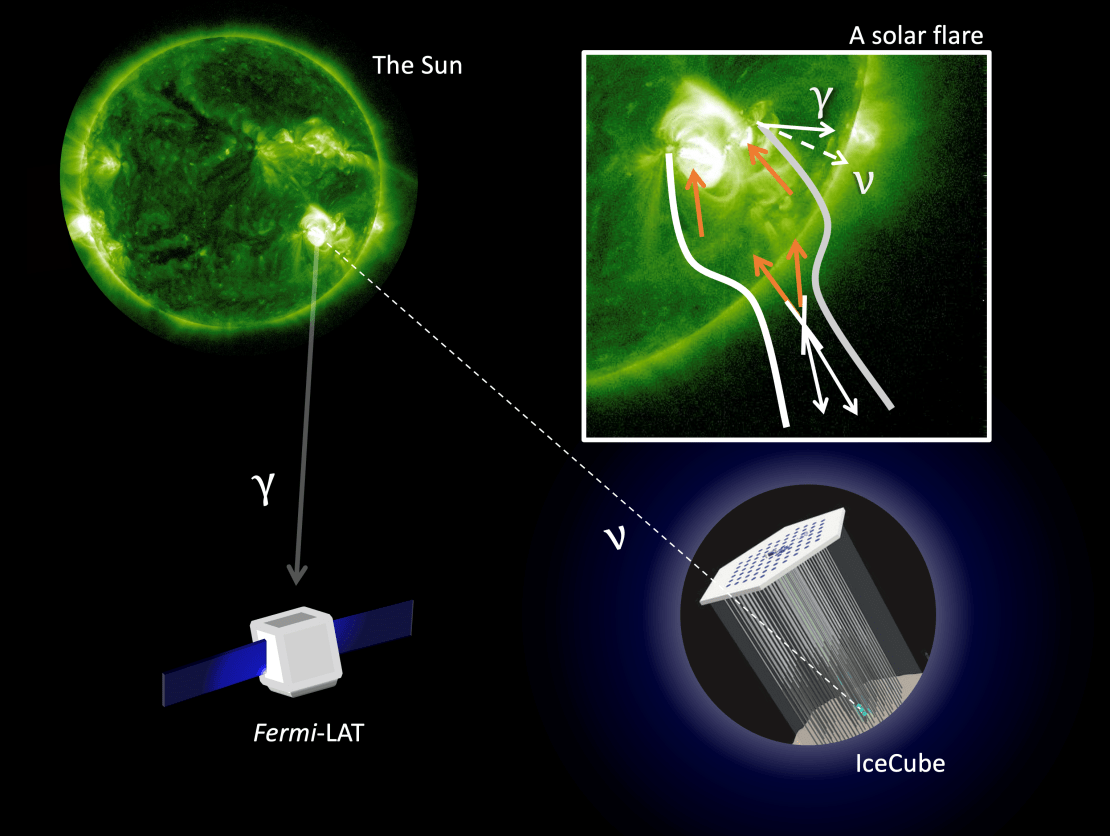Our sun shines not only in light but also in neutrinos. These tiny, chargeless, and nearly massless particles are produced deep in the sun’s core, but we also expect them to be created in the solar atmosphere, either by collisions of cosmic rays or during solar flares.
The IceCube Neutrino Observatory at the South Pole, a cubic-kilometer web of light sensors embedded a mile deep in ice, might be able to find those predicted solar flare neutrinos. Even though IceCube was designed to detect neutrinos accelerated to high energies in outer space—energies much higher than those of solar flare neutrinos—IceCube collaborators were intrigued by the transient nature of solar flares and found a way to conduct the search with data from their South Pole detector.
In a paper recently accepted by Physical Review D, the IceCube Collaboration presents the results of the first IceCube search for neutrinos emitted during solar flares. While the search turned up empty for now, the collaboration established new upper limits and has been able to use their new low-energy event selection to expand the energy range for other searches.

Solar flares happen when magnetic field lines on the sun’s surface get tangled or crossed, resulting in a sudden explosion of electromagnetic energy. Because of the magnetic reconnection, particles—including protons—can be accelerated to high speeds toward space or toward the solar atmosphere itself. These protons can interact with dense plasma in the lower solar atmosphere, producing mesons that subsequently decay into gamma rays and neutrinos.
But these aren’t the neutrinos that IceCube was originally built to detect. IceCube was designed to see signals from neutrinos with TeV (1012 electronvolt) energies—though a denser cluster of sensors at the center of the array, called DeepCore, brings the energy threshold down by a couple of orders of magnitude to 5–10 GeV. In order to capture neutrinos from solar flares, which are expected to have MeV (106 electronvolts) to GeV energies, IceCube collaborators had to use their detector in a completely new way.
So, they developed an innovative event selection that lowered the detection threshold to 500 MeV. Several steps in the selection allowed them to get rid of high-energy neutrinos (usually considered the interesting part) and detector noise, which made up the main background for this search.
The researchers then applied the new event selection to archived IceCube data recorded during bright solar flares. Instead of just searching X-ray–bright solar flares, as was done in a search in the 1980s, the researchers decided to focus on five solar flares that were bright in gamma rays. These gamma rays were likely produced by the decay of pions that were created when protons were accelerated by the solar flare. “Since pions would also produce neutrinos when decaying, the gamma-ray signature was a very good hint for identifying promising solar flare neutrino candidates,” says Gwenhaël de Wasseige, a Marie Curie individual fellow at APC Laboratory in Paris and a lead on this analysis.
However, their search did not reveal any significant neutrino signature or signal: In the five solar flares studied, IceCube did not see an increased number of GeV neutrinos, and the observations were consistent with background expectations. So the researchers set upper limits that allowed them to rule out one of the two theoretical models.
The result shows that IceCube can be a powerful instrument to detect astrophysical neutrinos across a very wide energy range. IceCube researchers drew from this work to develop an event selection that can be applied to more than just solar flares; they used it to search for GeV neutrino counterparts from gravitational wave events seen by LIGO and Virgo, and they are publishing those results soon.
“This analysis is a great example of the flexibility of the IceCube detector,” says Erin O’Sullivan, professor at Uppsala University and another IceCube collaborator. “Even after ten years of operation, we are constantly finding novel ways to analyze the data in order to access new physics opportunities.”
To continue probing solar flares, the collaboration needs more data, which may come as the neutrino detector landscape shifts. Forthcoming detectors like the IceCube Upgrade and KM3NeT will be more sensitive to low-energy neutrinos, and combined analyses might reveal a signal from solar flares. Plus, says de Wasseige, “The 11-year cycle of the sun is restarting, and we can expect more bright solar flares with it. If we manage to lower the upper limits enough, even a nondetection could constrain the upper cutoff and lead to useful information for the solar community.”
+ info “Search for GeV Neutrino Emission During Intense Gamma-Ray Solar Flares with the IceCube Neutrino Observatory,” IceCube Collaboration: R. Abbasi et al., Physical Review D 103 (2021) 10, 102001, journals.aps.org, arxiv.org/abs/2101.00610